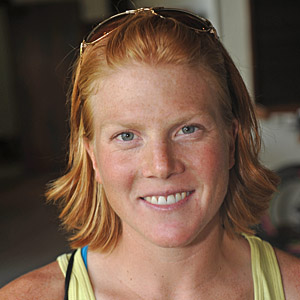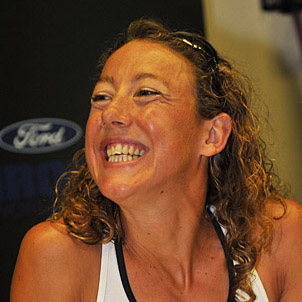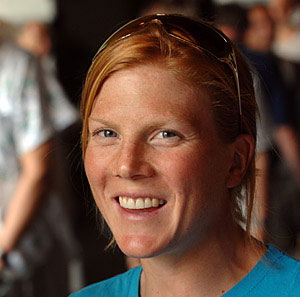Samantha McGlone’s quiet return

KAILUA-KONA, Hawaii — Samantha McGlone enjoys being the stealth competitor in 2009, coming into Kona almost unnoticed and in the shadows while today's dominant star Chrissie Wellington basks sits in the spotlight. In many ways, McGlone has traded places with Wellington, who came to Kona in 2007 as a virtual unknown while McGlone was the highly touted rookie, the first Ironman 70.3 World Champion, a co-favorite. On that day, McGlone perfectly executed her plan, ran a 3 hour flat marathon, and lost by five minutes to the prodigy honed by super coach Brett Sutton. Five minutes may sound like a big margin, but last year Wellington's closest competitor trailed by 15 minutes – and that after Wellington lost 10 minutes struggling with a flat. A 25-minute margin of victory would have equaled the biggest margin of the modern era, executed by none other than Paula Newby-Fraser in 1992.
Unfortunately, McGlone wasn't among Wellington's challengers, since she was knocked out of competition – and almost out of her career – by a hard to diagnose, hard to treat trouble with her Achilles tendon. The search for a treatment and her rehab cost McGlone more than a year in her prime. And her return to competitive fitness has been very gradual, with times and splits way off her natural best marks.
But now that there are no physical hurdles in her way, McGlone has returned to Kona with faith in the eventual full return of her prodigious gifts. She looks happy and confident two days before a return engagement on the Queen K.
Slowtwitch: Things are very different today than your debut at Kona in 2007.
Samantha McGlone: Two years ago, I had a great debut. But halfway through the next season, I got injured – it's called Achilles tendonitis – and it turned out to be much more serious than we first thought. It could have been a career ending. But thankfully we finally found great people to work on it. I took a good six months off last winter. No biking, no running.
ST: For someone with your appetite for hard work, that must have been tough.
Samantha: It was nice to take a little time off. I started to run again in February. Twenty minutes walk-jog. Now I'm here and fit and ready to go in October. I think I'm even stronger in the swim and the bike. I'm riding really well.
The key moment in the 2007 Ironman came when the unknown Chrissie Wellington came up to the serious chase group that included McGlone about mile 80 of the bike. Thinking she could run down the rookie, McGlone didn’t pursue Wellington when she surged ahead. McGlone ran at Wellington's pace, but never made up the five minutes Wellington gained the last 30 miles of the bike.
ST: That's encouraging news. When you first returned to racing, your run was 5 to 7 minutes off your typical 1:19 half marathon splits in 70.3 races.
Samantha: On the run, I'm coming from doing base work all year. The last time I race here I came from doing 34, 35 minute 10ks and speed work. And the last time I raced here, I was more worried about the distance. Now I have the distance under my belt. Now I do not have 35 minute 10k speed, but I don't think you need that here.
ST: The only time you faltered – just slightly, was the last 10k of the run.
And you still ran 3 hours flat.
Samantha: I have been working on my strength at the end of the day. I think the end of the run will be a lot more solid than I was in 2007, when I struggled at the end. The first one I fell apart a little the last hour. That's to be expected.
ST: There's been a lot of competition the last two years in the women's field.
Samantha: I think this year will be a lot more competitive. There are a lot of girls who are really solid and racing fast. And that will be exciting.
ST: It sounds like you had a hard time solving the mystery of your injury?
Samantha: Absolutely. It was a very challenging injury. I saw many people at first. Nothing seemed to be working and nothing was getting better.
ST: So who came to the rescue and what did they do?
Samantha: I had a good team of endurance sports therapists in Phoenix. (She and her husband, coach Cliff English, moved from Colorado to Arizona in late 2007) They really took the time. They analyzed my bike position and got to the root of the problem and fixed it with innovative techniques so I didn’t have surgery – thank goodness!
ST: How bad was it?
Samantha: I was at the point I could not run anywhere without pain. It was on the verge of not being a tendon any more. It was pretty destroyed.
ST: What caused it?
Samantha: I had a slight eccentric movement in my pedal stroke. I sat just a little off center. That didn’t matter in short races. But training for Ironman, I went mile after mile and it aggravated it. We are talking just a few millimeters. But that's a lot of pedal strokes. But it hurt more on the run.
ST: What did that do to your Achilles?
Samantha: Thousands and thousands of pedal strokes left it a big gooey mess. It was all a big ball of fluid. It just became a big ball of slush. So it became necessary to wait for the body to re-structure and build back the tendon.
ST: That might take a long time. What did the doctors and therapists do to hurry things along?
Samantha: It can take years. But you can stimulate it. They did a lot of scraping on the tendon to stimulate regrowth of the tendon. It feels really painful. They also used nitro patches.
ST: Sounds explosive.
Samantha: Yes. But it's a vasal dilator which lets more blood flow into the area. It's a new technique which works very well. That and rest and scraping and careful eccentric exercises. I had to be diligent every single day. Once we settled on treatment, it took six months before it was really ready to start full training.
ST: You were out a long time.
Samantha: It was 12 months. People forget I raced a lot before I had to quit last July. I won three half Ironman races in early 2008. Unfortunately I had to miss Kona.
ST: Your first races were not up to Sam McGlone speed. By this June, I'd say I was 50 percent race fit. I'd been training three months before I finished second at Honu 70.3. By Lake Placid, where she finished third and qualified for Kona while running 3:15 marathon.
Samantha: I think I was maybe 80 percent at Lake Placid. By now, I think I am 90 to 95 percent. This year I am definitely stronger. The last three weeks have gone really well and things are night and day from three months ago.
ST: Does it feel good to come in under the radar? Or do you have a few pangs about being out of the spotlight?
Samantha: I like to come and do my own race with not so much hype. It's hard to sneak back into the dark horse role. I always loved that and this was definitely a blessing in disguise.
ST: Mirinda Carfrae seems to be in the position you were in 2007.
Samantha: Mirinda has been doing great all year and I think she will have a great day. She's a smart girl, has a great coach in Siri Lindley and she is a great athlete. I see a lot of similarities to where I came from. I have no doubt she will do as well as I did.




Start the discussion at slowtwitch.northend.network